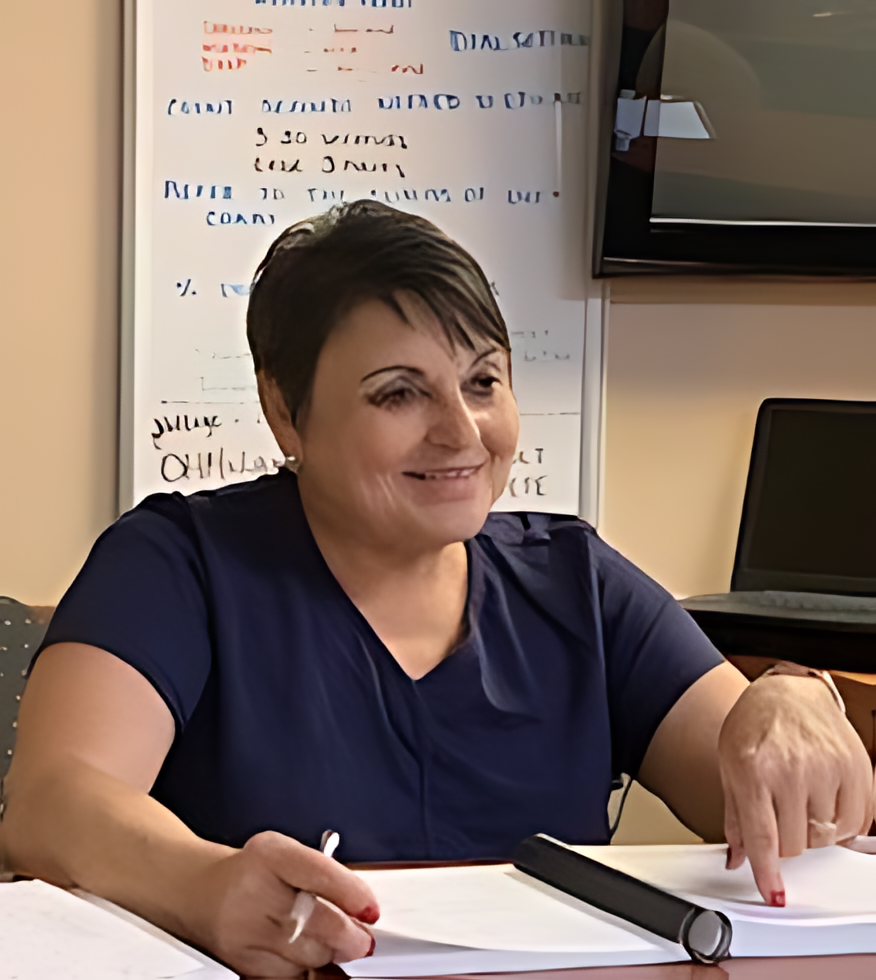Due to its length, our profile of Synoptic Product’s Electrologist of the Month Ms. Vickey Mickey is posted in two parts.
This post discusses her role in enabling electrologists to perform laser in Ohio and her thoughts on the future of the hair removal industry. Part 1 highlights Ms. Mickey's early career and initial involvement on creating licensing standards in the state of Ohio and may be found here.
Part 2 of 2: Q & A with Ms. Vickie MickeyVickie Mickey’s career has had a far-reaching impact in her home state of Ohio where she has worked as an electrologist, business owner, cosmetic therapy school founder, educator, and licensing advocate for over three decades. Historically, Ohio is the only state in the U.S. that licensed electrologists under the more broadly defined role of Cosmetic Therapists. Because of this, the terms Electrologist and Cosmetic Therapist are used interchangeably in this profile of Ms. Mickey. She founded an electrology school named the Cosmetic Therapy Training Center (CTTC) in 2011 and has served as President of the International Guild of Professional Electrologists, President of the Cosmetic Therapy Association of Ohio and Member of the State Medical Board of Ohio Advisory Committee.
Ohio Licensing for Laser Hair RemovalIn addition to her role as an advocate for the licensing of cosmetic therapists in Ohio, Ms. Mickey played a pivotal role in establishing the licensing law that allowed cosmetic therapists to practice laser hair removal in Ohio. When laser hair removal first began to be practiced in Ohio, the statute allowed nurses and physician assistants to perform laser “under the supervision of a physician”, which functionally meant that laser hair removal was limited to doctor’s offices.
As was happening throughout the U.S. in the 1990s, Ms. Mickey found that her electrolysis business fell when potential clients chose laser hair removal instead of electrolysis, and she decided to learn more about this new modality. Discussions at the State Medical Board as to whether electrologists could begin to operate this new technology began as early as 1995 but were inconclusive. After watching her income steadily drop, Ms. Mickey decided to act. In 1998, she travelled to Naples, FL, to complete a 30-hour training with Wally Roberts, the founder of one of the first training centers for laser hair removal, and upon returning home to Ohio, she purchased a laser machine for her office.
After having committed to this substantial investment in new equipment, Ms. Mickey figured that she’d better hurry up and get licensed to use it! She reached out to the CTAO lobbyist and attorney who advised her not to use it until after licensing had been determined. And this is where it the story gets juicy-
“At the next meeting of the State Medical Advisory Board Committee of which I was a member, the discussion to define licensing for cosmetic therapists in the use of laser was placed on the agenda. The physicians went around the room and gave their opinions on the issue of who could and could not use laser, and some members showed by their comments that they didn’t understand the technology at all. After the physician’s had had their say, the CTAO attorney turned to me and said, ‘You need to say something.’
“I was shaking- I’d made a huge investment in purchasing a laser machine, and I didn’t know what I was going to do if we couldn’t get the licensing to pass. So I steadied myself and said simply, ‘The state statute permits the cosmetic therapist to utilize permanent hair removal using an electrical modality that’s approved by the FDA.’ The truth was, due to the language of the statute, we weren’t limited to the use of only the needle. It would have been a trade restriction not to allow cosmetic therapists to use the laser. At that point, the waters parted. A private meeting was adjourned in a separate room, and when it concluded, the attorney returned quickly to tell me, ‘We’re going to work this out.’
Ms. Mickey, please tell us the dramatic story of the night the legislation passed.“There were a series of steps needed to turn the resolution into a state statute. The first step was to attend meetings with the State Medical Board to define the parameters of laser practice and how it would be licensed alongside electrolysis. Then, after the statute was developed and passed by the state board, there are other meetings that are required before it can become law, including a hearing where people can come in and make comments on the legislation.
“During this hearing, I had to stand up and testify against the lobbyist for Dermatologists and Plastic Surgeons who was fighting the statute since it would result in a loss of income for those medical specialties whose offices had had a virtual monopoly on laser hair removal.
“The night that the legislation was due for a vote, the meeting was being held in a high rise building in downtown Columbus, and that particular evening, a tornado had been spotted approaching the city. Naturally, there was a rush to take the vote and end the meeting as quickly as possible. The vote was concluded in the affirmative, and the room cleared immediately, with attendees rushing to exit the building through an underground tunnel to get to the parking lot.
“I ended up just ahead of the lobbyist for the Dermatologists and Plastic Surgeons who approached me and said, ‘I can’t believe you did this!’ and then started berating me. I turned to her and said, ‘I won,’ and just walked away.
“Ohio was one of the first states in the nation to allow the use of lasers for hair removal outside of a physician’s office, and in retrospect, I believe that my work set a precedent for the nation as far as acceptance for electrologists and cosmetic therapists using lasers is concerned. From this point on, practitioners in Ohio had to take a laser certification test to be able to perform laser hair removal.
“In 2021, the governor ‘sunshined’ (terminated) the requirement for cosmetic therapists to be licensed by the state, and by removing the licensing for cosmetic therapy and electrolysis, it also meant that there was no longer licensing for electrologists to use lasers. I have a lot of money invested in laser equipment in my school and office, so I immediately hired a lobbyist and reached out to the CTAO and fellow cosmetic therapists to help support the expense of this effort.
“I testified before the State Senate, and we were successful in our bid for current laser certifications to be ‘grandfathered’ [a legacy clause that provides an exemption allowing persons to continue with activities that were approved before the implementation of new regulations or laws]. From that point on, new laser practitioners are required to complete 750 hours of instruction including 50 hours on laser technology (20 didactic and 30 clinical) and pass the Society of Clinical and Medical Hair Removal’s national certification exam. In addition, cosmetic therapists must have a physician consent before administering the initial laser treatment for new clients.
“Regulations can differ so greatly between states. Ohio has pretty restrictive statutes that govern licensing for the use of laser; West Virginia requires no license; Kentucky just instituted new licensing requirements; and there is licensing in Michigan for electrolysis but not for laser- which is scary. In Michigan, you can buy a laser machine and just start using it without any training. I wish that the United States could embrace a consistent standard all the way around.”
Ms. Mickey, please tell us about opening your school, the Cosmetic Therapy Training Center (CTTC)?“I felt that there was a viable need for a cosmetic therapy school in Ohio, and after an arduous, 2-year application process to satisfy requirements of both the State Board of Regents and the Board of Career Colleges and Schools, I opened the Cosmetic Therapy Training Center in 2011.
“What I’ve seen is that the better the education, the better the electrologist, and maintaining that education through continuing education is essential. Before the 2021 ‘sunshine’ licensing change, 25 hours of continuing ed was required annually and enforced through inspection, but unfortunately, Ohio no longer has this requirement. But really, continuing education is essential, because the world changes. And if you don’t keep up, your skills will cease to be first rate.
“I applaud the national organizations for their support of continuing education because I think it’s very important. When we talk about how the regulations around licensing affect individuals, Ohio offers a good example. During the pandemic, many of the older members of the CTAO retired, and then with the 2021 change in licensing, the state no longer collected contact information for working cosmetic therapists in Ohio. This has meant the loss of a comprehensive database of contact information to get information out to colleagues in the industry and ultimately less ability to support one another and work together on issues important to our industry.”
Ms. Mickey, what factors do you think will influence the future of electrolysis and cosmetic therapy?“I applaud manufacturers who make reliable equipment because it makes our job easier. For example, I only use Ballet needles in my practice- they’re the best.
“I was introduced to Ballet needles a few years after attending a conference for electrologists in 1986 where we were instructed on the CDC’s guidelines for sterilization and hygiene in the wake of the HIV/AIDS epidemic. Up until that time, needles and probes weren’t sterile, there was no use of gloves- it was a nightmare! One of the CDC’s recommendations was to use sterile, disposable, single-use needles. I hadn’t tried Ballet needles yet, and the two piece needles I was using were flimsy and would often break.
“I purchased my first Ballet needles from Jim Paisner at a conference, and I never went back. I love them- they’re stable and they conduct electrical current right. I start my students on the F-shank Stainless Steel needles- all sizes. Right from the beginning, their kit includes sizes 2, 3, 4, and 5 needles, and students start right away with matching the size of the needle to the thickness of the hair.
Ms. Mickey, any last thoughts that you’d like to share with readers?“There continues to be a need for more hair removal professionals in the world including more electrologists, and they need a decent education and proper tools to work with!
“Although the adoption of laser initially diminished the industry, my experience is that laser is an essential tool for hair removal. In clinical studies, laser removes 87% of hair growing in a cycle. By reducing the majority of hair in a growth cycle, using laser helps reduce the costs for the patient and can be much more comfortable. That doesn’t mean that all hairs are good targets for laser. After hair reduction, you still need that needle to finish hair removal effectively.
“In 2008, legislation went through in Ohio that allows nurse practitioners to operate lasers without oversight by a physician. However, most of them have no education about the anatomy and physiology of hair growth and don’t understand the growth cycles of the hair. I feel that it’s unprofessional that patients can sign up for ‘guaranteed unlimited hair removal’ at a medical spa for outrageous amounts of money. Well, guess where they end up? Here. Sometimes after 23 laser appointments. Because the client isn’t receiving any understanding of the modality or how it works, they don’t know what appropriate hair removal should look like.
“I sometimes get discouraged with my students because they only want to use the laser and not learn electrolysis. It’s really disappointing. In my current practice, I still have days where I perform electrolysis for 5-6 hours per day. There is a great demand for electrolysis because there are some hairs that laser simply won’t target.”



Leave a comment